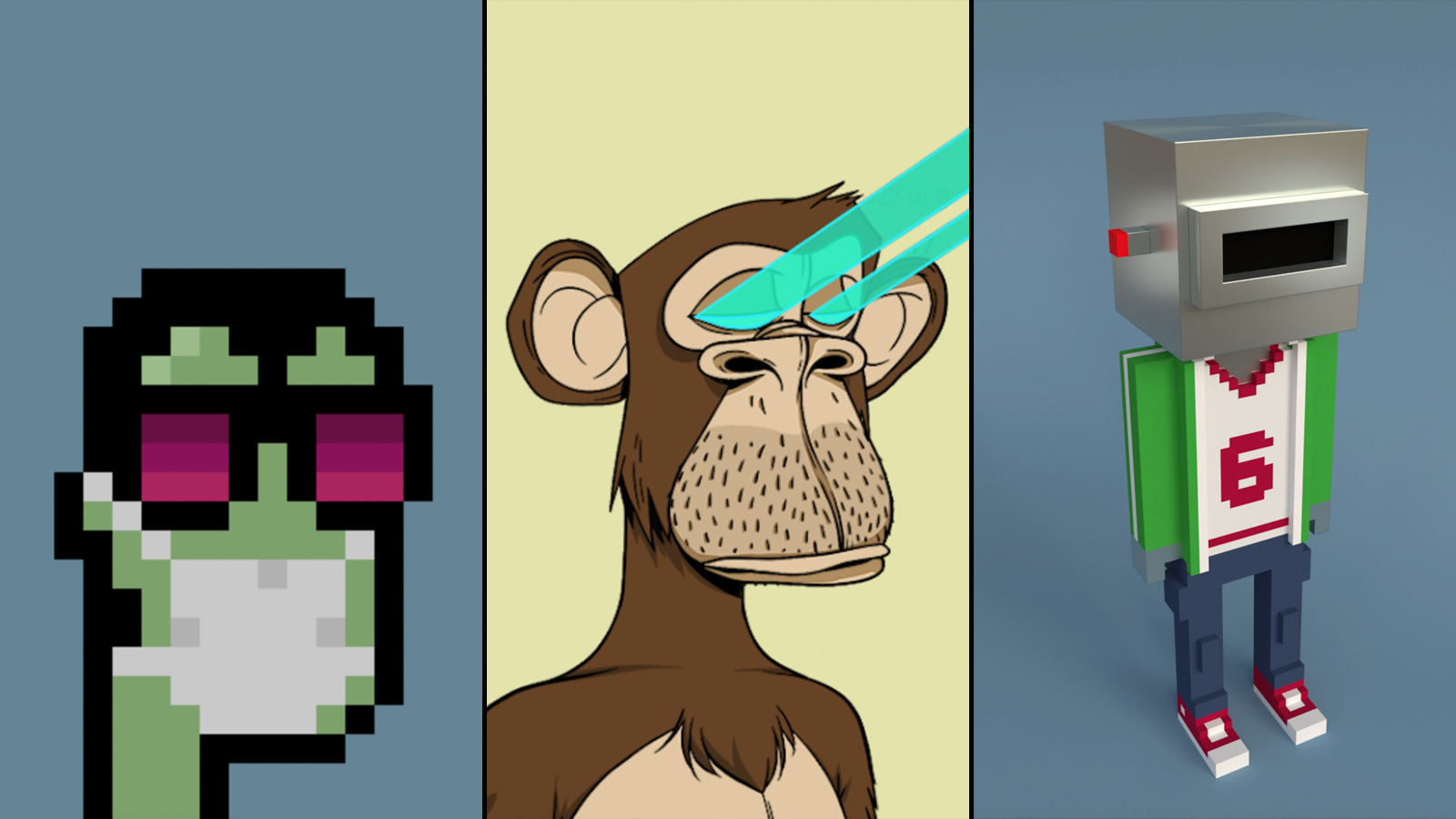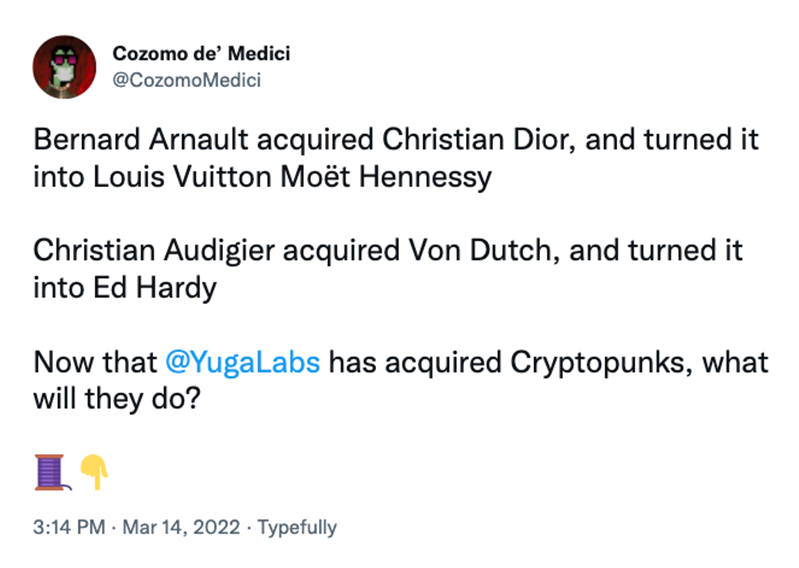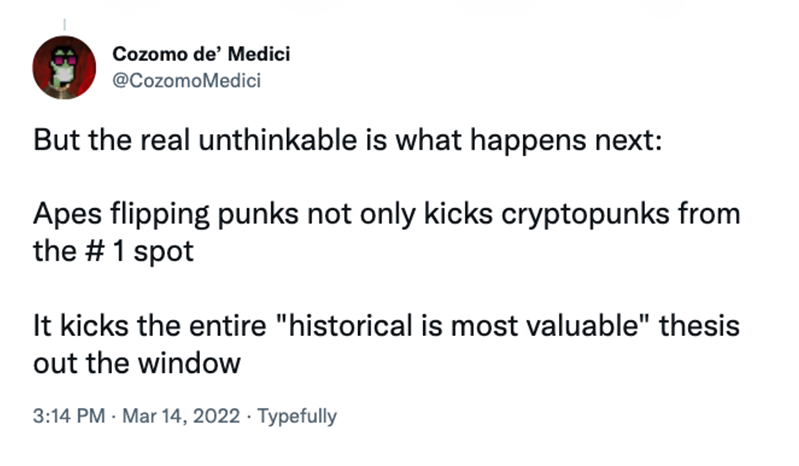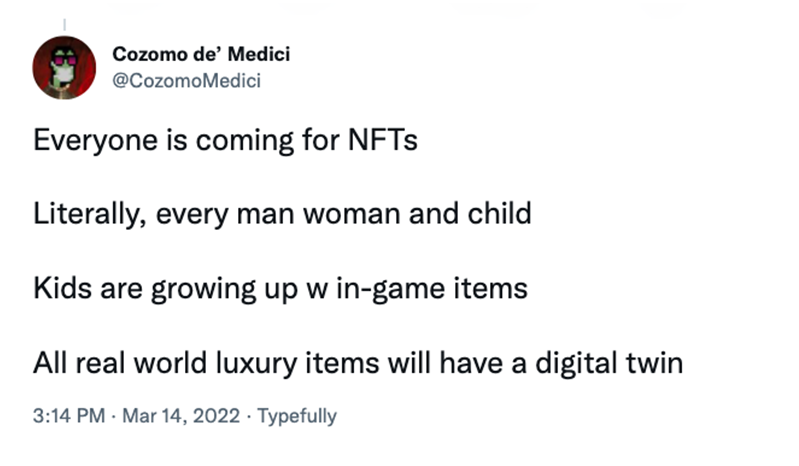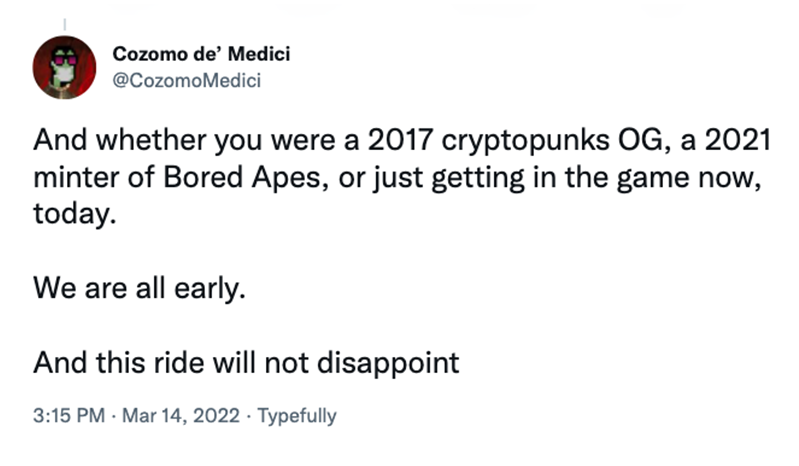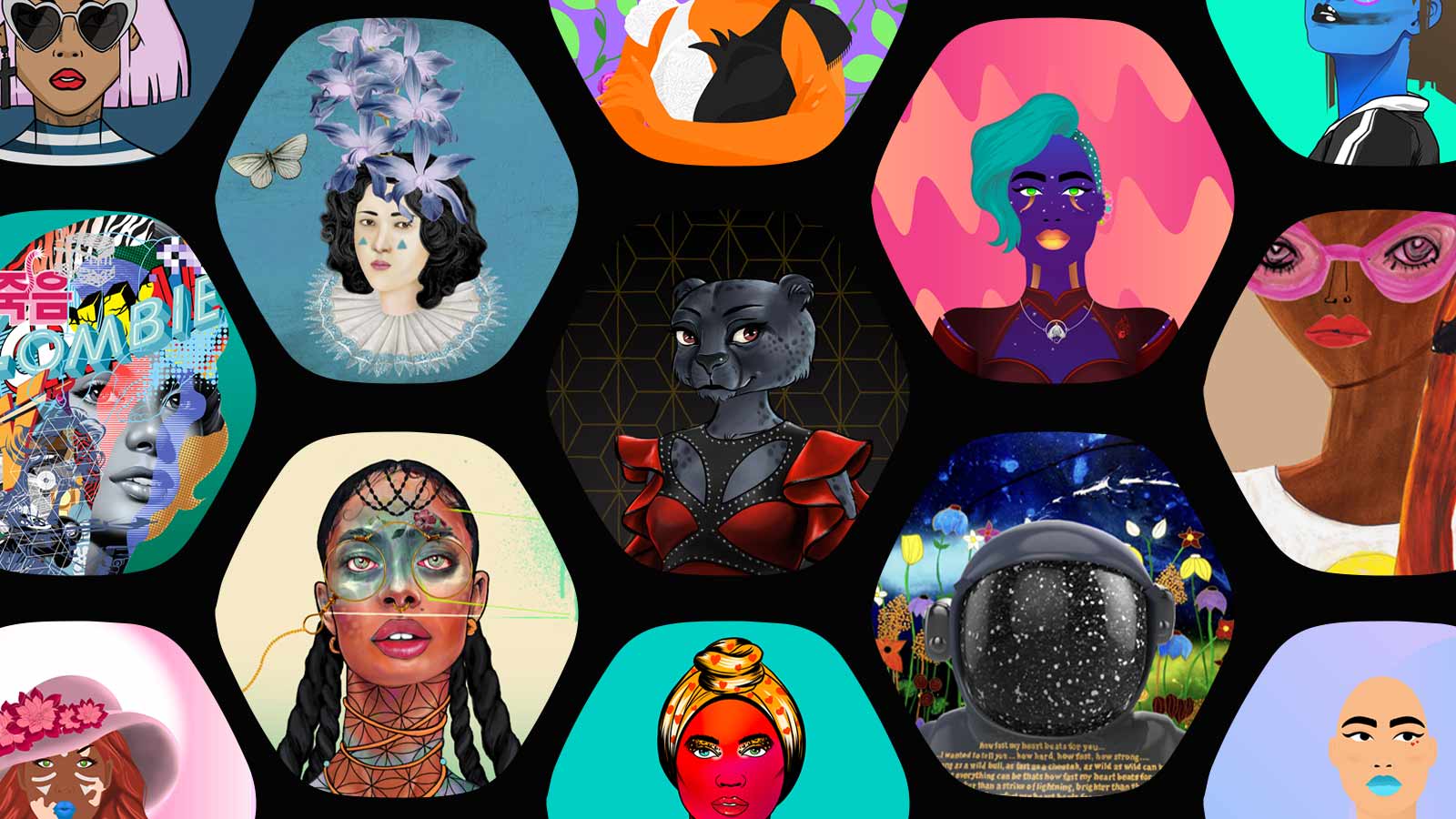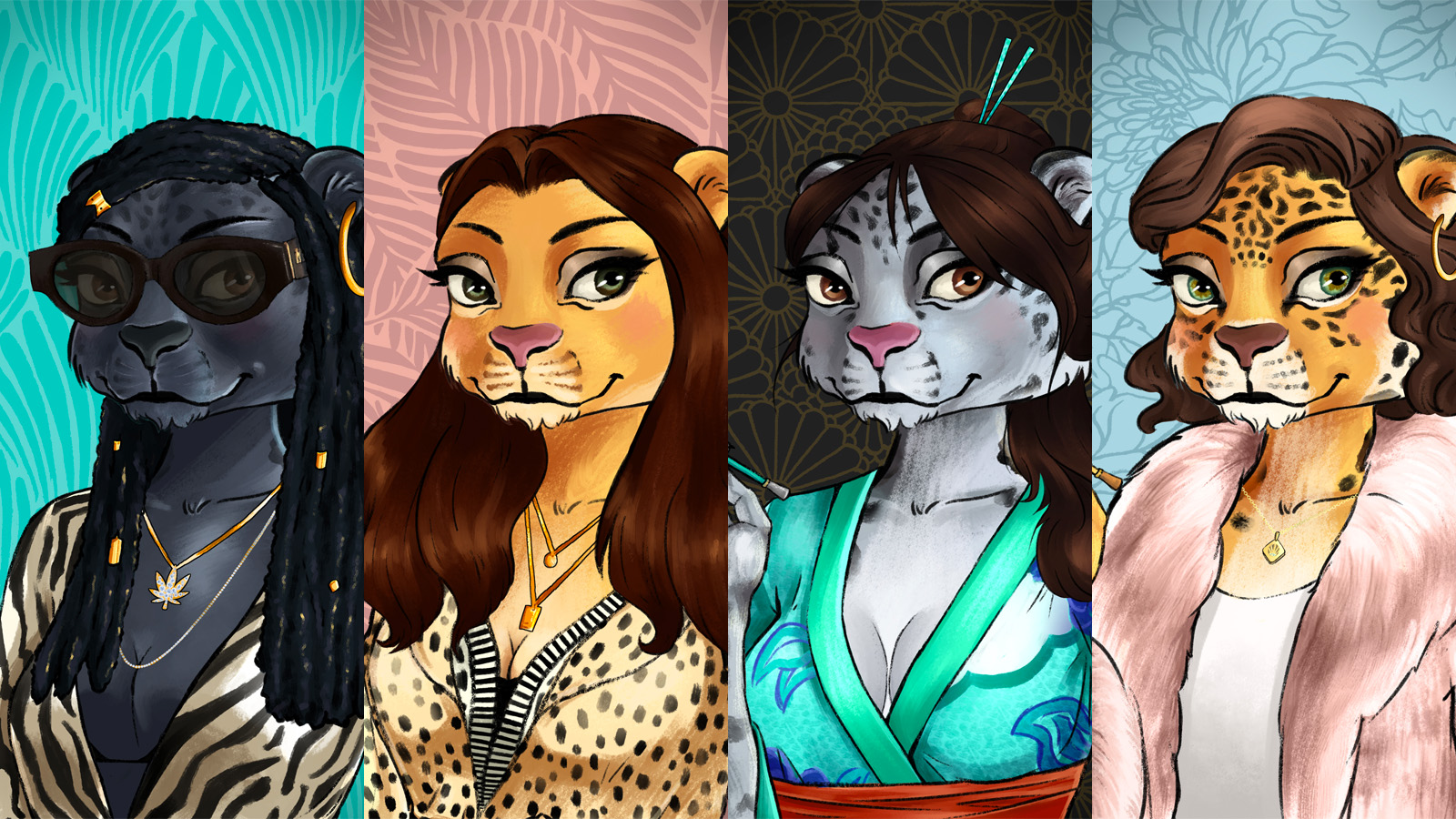On March 14, 2022, Cozomo de Medici tweeted to the NFT community. This in itself was nothing new, the prolific account regularly tweets about the NFT marketplace. De Medici is one of the most respected and active influencers in the NFT space.
If you’re not immersed in the NFT community, you may know Cozomo de Medici by another name: Snoop Dogg.
What was interesting about de Medici’s tweet on March 14 was his thoughts on the future of the NFT marketplace in the wake of one of the biggest acquisitions in NFT (non-fungible token) history.
“Bernard Arnault acquired Christian Dior, and turned it into Louis Vuitton Moet Hennessy. Christian Audigier acquired Von Dutch, and turned it into Ed Hardy. Now that YugaLabs has acquired Cryptopunks, what will they do?” the NFT collector (and D-O-Double G) pondered.
Punks, Apes, and Meebits (oh my)
Yuga Labs, creators of the Bored Ape Yacht Club, recently announced that they have acquired the rights to Larva Labs, creators of the CryptoPunks and Meebits NFT collections.
Bored Ape and CryptoPunks are the two most valuable NFT collections by market cap, holding a combined worth at a minimum of some $3.6 billion at current prices.
The CryptoPunks project was launched in 2017. The 10,000 piece project, inspired by the 1970 punk movement in London, is considered the original NFT project and the Granddaddy of NFTs.
The founders of Larva Labs, a New York-based software company, created a software program that would generate thousands of different characters. They thought they may have the makings of a smartphone app or game. They ended up shifting the paradigm around art collection, instead.
While anyone can view—and even save a copy of–images of the Punks, official ownership of a Punk is coded in a smart contract on the Ethereum blockchain. The Larva Lab system of ownership inspired the now widely-accepted ERC-721 standard for NFTs.
A few months after launching the project, Punks began to sell for thousands of dollars. By 2021, Punks were selling for an average of 15.45 ETH ($30,412.40). Some Punks were selling for millions of dollars.
It was a success that Larva Labs was able to duplicate when its second collection, Meebits, pulled in nearly $20 million worth of ETH in its first two hours.
About the time the Punks were being bought for record-breaking sums, another group of software developers entered the NFT space.
Yuga Labs created a 10,000 generative art collection featuring cartoon primates. These bored, hipster-looking NFTs functioned as more than just collectible digital art; the tokens also became a membership key to the Bored Ape Yacht Club.
The project’s name, Bored Ape Yacht Club, came from the concept of a club for people who struck it rich quick by “aping in” — crypto slang for investing big in something unsure. The digital clubhouse is the polar opposite of a fancy yacht club; it’s designed to look like a dive bar in the middle of an Everglades swamp.
Like the Punks, the Apes have made their creators millions of dollars and have spurned plenty of wannabes in the NFT market. They are two of the most well-known, successful, and oft-imitated collections in the space.
And now they both fall under the umbrella of Yuga Labs.
Snoop Ponders the Future of NFT Market After Larva Lab Purchase
Back to Snoop, ahem, Cozomo…
In a series of tweets, de Medici recounts the day he bought his first Punk. (July 31, 2021, in case you’re taking notes.) It was “a wild day in history,” according to the NFT collector, kicking off “the JPeg summer of ‘21.”
A hunt was on for the most valuable and significant NFTs. For many collectors, that meant finding the OG NFTs.
“Those with the richest history were the most valuable,” de Medici tweeted. “And all are put on a timeline related to Larva Labs projects.”
De Medici goes on to describe the NFT market’s sentiments, which basically equated to first is best. Or, as Ricky Bobbi would say, “If you ain’t first, you’re last.”
“The significance of what Larva Labs created cannot be overstated. Not just Punks but Meebits and Autoglyphs too. [Larva Labs founders] Matt and John are some of the most important artists, not just in NFT, but imo all of human history.”
That’s big praise from the master of music and personal branding.
De Medici shifts his praise, though, calling out the Apes for one very special distinction they held over other NFT artists, including Larva Labs.
“But one day in November, one seemingly little thing Bored Apes Yacht Club gave you that CyrptoPunks didn’t started to mean something…
You see, Bored Ape owners ‘owned’ commercial rights to their apes.”
Unlike the CryptoPunks, Yuga Labs transferred full commercial and IP rights to their NFT as part of the purchase of their Apes. That means Ape owners are free to take their image and use it in new, creative ways. Ape bands, ape books, ape movies, ape talent agencies… the sky is the limit.
Suddenly, recounts de Medici, the “unthinkable” happens.
“The floor price of Bored Apes flips the floor price of CryptoPunks. The derivative has surpassed the original. The mighty king has fallen. And wtf do we do now?”
The “de-throning” of Punks “kicks the rocks out from under the historical thesis.”
Suddenly, NFT value is not automatically granted to the oldest collections just because they came first.
The Metaverse is now in a (virtual) Gold Rush.
And like its historical predecessor, the true value is not in returning to the original site where nuggets of gold were first discovered, but rather in finding new, undiscovered potential.
Where will the next treasure be found?
Unfortunately for those who are still trying to find fortune by creating the next ape-derivitive copycat collection, the next big thing in the NFT space is going to come from originality, not from copying a previously successful collection.
Fortunately, originality, community, and philanthropism is abundant.
World of Women brought female-led NFT projects into the limelight and caught the attention of Reese Witherspoon, who not only bought her first NFT from the collection, but is also partnering with WoW to create scripted and unscripted TV shows, live events, and featured films around the collection.
The Flower Girls brought fine-art to the NFT space with a collection by artist Varvara Alay that’s donating 20% of profits from both primary and secondary NFT sales to children’s charities. Flower Girls recently announced a partnership with Dolphin Entertainment for opportunities in scripted and unscripted television series, digital and traditional publishing, consumer products, music, gaming and events.
WomenRise NFT collection was created by a 26-year-old artist and activist who is using her collection as part of a movement for women’s rights and girls’ education. WomenRise’s ultimate goal is to build the first school in the metaverse for the 258 million children around the world who have no access to education–129 million of them are girls.
1687 has created custom NFTs for token holders, pushing the NFT PFP trend even further by letting club members create their own avatar using an AI builder or utilizing a stylist and team of artists to create bespoke avatars that represent their physical self or brand. This female-led NFT project is focused on social good projects and bringing together entrepreneurs and icons in the sports and entertainment worlds to collaborate on producing projects that support equality, representation, and inclusivity.
According to Cozomo de Medici, this is just the beginning.
“Everyone is coming for NFTs. Literally, every man, woman, and child. Kids are growing up with in-game items. All real world luxury items will have a digital twin.”
“And whether you were a 2017 cryptopunks OG, a 2021 minter of Bored Apes, or just getting in the game now, today. We are all early. And this ride will not disappoint.”
For more information about 1687’s custom NFT builder and upcoming collabs and projects, follow us on Twitter.
